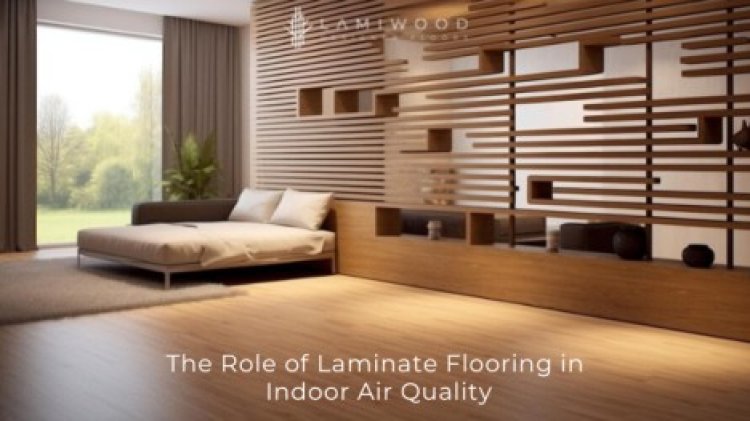The Role of Laminate Flooring in Indoor Air Quality
This article explores the role of laminate flooring in IAQ, its benefits, and considerations, including its application in kitchens.
Share this Post to earn Money ( Upto ₹100 per 1000 Views )

Indoor air quality (IAQ) is a critical aspect of home health, significantly impacting the well-being and comfort of its occupants. Flooring materials play a crucial role in determining IAQ, as they can emit volatile organic compounds (VOCs) and other pollutants. Laminate flooring has gained popularity due to its aesthetic appeal, durability, and affordability, but how does it affect indoor air quality? This article explores the role of laminate flooring in IAQ, its benefits, and considerations, including its application in kitchens.
Understanding Laminate Flooring
Laminate flooring is a multi-layer synthetic product fused together through a lamination process. It typically consists of a wear layer, a photographic applique layer that mimics the appearance of wood or stone, a core layer of high-density fiberboard (HDF), and a backing layer for stability. The popularity of laminate flooring stems from its versatility, ease of installation, and cost-effectiveness compared to traditional hardwood or stone flooring.
Impact on Indoor Air Quality
Emission of Volatile Organic Compounds (VOCs)
One of the primary concerns regarding laminate kitchen flooring and IAQ is the emission of VOCs. These are chemicals that can evaporate into the air and potentially cause adverse health effects. The core layer of laminate flooring, made of HDF, may contain formaldehyde, a known VOC. However, advancements in manufacturing processes and regulations have significantly reduced the emission levels of formaldehyde in modern laminate flooring.
Look for products labeled as low-VOC or CARB Phase 2 compliant, which adhere to stringent standards for formaldehyde emissions. These products are safer for indoor environments and contribute to better IAQ.
Allergy-Friendly Flooring Option
Laminate flooring is a hypoallergenic option compared to carpets. Carpets can trap dust, pollen, pet dander, and other allergens, contributing to poor IAQ. Laminate flooring, on the other hand, has a smooth surface that is easy to clean and does not harbor allergens, making it an excellent choice for individuals with allergies or asthma.
Easy Maintenance and Cleaning
Maintaining good IAQ involves regular cleaning to remove dust, dirt, and other pollutants. Laminate flooring is easy to clean with simple sweeping or vacuuming and occasional damp mopping. This ease of maintenance helps in reducing the accumulation of allergens and pollutants, thereby enhancing IAQ.
Benefits of Laminate Flooring
Durability and Longevity
Laminate flooring is known for its durability and resistance to scratches, stains, and fading. This makes it suitable for high-traffic areas in the home, such as kitchens, without compromising on air quality.
Aesthetic Appeal
Laminate flooring can mimic the appearance of natural wood, stone, or tile, offering a wide range of design options to suit any interior style. Its ability to replicate the look of more expensive materials makes it a popular choice for homeowners seeking a cost-effective flooring solution without sacrificing aesthetics.
Cost-Effectiveness
Compared to hardwood or stone flooring, laminate flooring is significantly more affordable. Its cost-effectiveness, combined with its durability and low maintenance requirements, makes it an attractive option for budget-conscious homeowners.
Laminate Flooring in Kitchens
Kitchens are one of the most frequented areas in a home, necessitating flooring that is both durable and easy to clean. Laminate flooring meets these requirements while also contributing to good IAQ. Spills and stains, common in kitchens, can be easily wiped off laminate flooring, preventing the growth of mold and mildew, which can negatively impact IAQ.
When choosing laminate flooring for kitchens, it's important to select products with water-resistant or waterproof properties to prevent damage from spills and moisture. Additionally, ensure proper installation to avoid gaps where moisture can seep in and cause damage over time.
Conclusion
Laminate flooring plays a significant role in maintaining and enhancing indoor air quality. With advancements in manufacturing and stricter regulations on VOC emissions, modern laminate flooring is a safer and more environmentally friendly option. Its hypoallergenic properties, ease of maintenance, and durability make it a practical choice for various areas in the home, including kitchens. By choosing high-quality, low-VOC laminate flooring, homeowners can enjoy a beautiful, durable floor while ensuring a healthy indoor environment.









